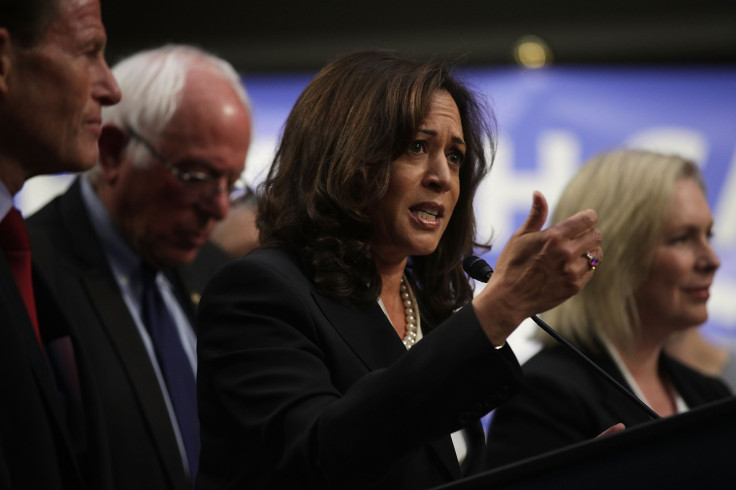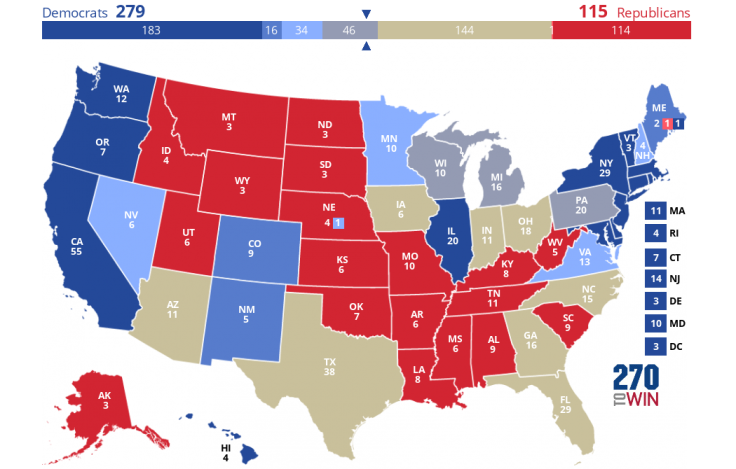Election 2020: Which States Can Democrats Flip To Win The White House And Defeat President Trump?

Potential 2020 candidates immediately generated interest after Donald Trump's upset victory in 2016, as the new president seemed vulnerable to losing a re-election bid after failing to win the popular vote and amid lingering questions as to whether he would even complete his term.
The current Democratic field has grown to 10 and continues to take shape with established names like Sen. Bernie Sanders of Vermont sharing the spotlight with relative neophytes such as Rep. Tulsi Gabbard of Hawaii.
Whichever candidate emerges as the nominee, the party has reason to feel at least somewhat optimistic about its 2020 chances regardless of whether Trump wins the GOP nomination. Special counsel Robert Mueller, who is nearing the completion of his investigation into Russian interference in the 2016 election, has already indicted or received guilty pleas from several prominent names with strong ties to Trump, including campaign manager Paul Manafort, personal attorney Michael Cohen, national security adviser Michael Flynn, foreign policy adviser George Papadopoulos and longtime adviser Roger Stone.
Trump also isn't particularly popular at the moment. A recent poll from Reuters/Ipsos showed Trump at just a 41 percent approval rating and a 55 percent disapproval rating.
The Democrats have decent momentum entering 2020. The midterms elections saw Democrats retake the House and make several races more competitive than expected.
Perhaps most importantly, the Democrats have a reasonable shot in 2020 of reclaiming traditional blue states that swung red in 2016. Hillary Clinton won the popular vote by 2.9 million votes and fell just 43 electoral votes short of the 270 needed to win the White House. Clinton's defeat can be blamed on losing three Democrat-leaning states — Michigan, Pennsylvania and Wisconsin — by a combined total of just 77,744 votes, which means Republicans may have justifiable concerns about once again securing those combined 46 electoral votes.
There is still a tough road ahead. The last time an incumbent lost was in 1992 and many Republicans remain unified in supporting Trump.
But Democrats, who have won the popular vote in six of the last seven presidential elections, can not only reclaim previous left-leaning and swing states but also add some others.
The election is a long ways away but a very early look at the 2020 race offers a glimpse at some of the key states the Democratic ticket will likely target.
Highest Likelihood - 46 Electoral Votes
Michigan (16 electoral votes) It was decided by 10,704 votes in 2016 and prior to Trump's victory, the Democratic nominee had claimed Michigan in six consecutive presidential elections. The signs are there that Democrats will win it back: both U.S. senators are Democrats and Democratic Gov. Gretchen Whitmer is coming off a landslide win in November. There might have been some overconfidence by Democrats in 2016, so they will likely fight harder the next time around.
Pennsylvania (20 electoral votes) It came as a big surprise to many that Trump defeated Clinton by 44,292 votes, which means Democrats will almost certainly not take Pennsylvania for granted after mostly comfortable wins in six consecutive presidential elections. Democratic Gov. Tom Wolf defeated Republican Scott Wagner by over 800,000 votes in 2018, so Democrats can feel hopeful about a win in 2020.
Wisconsin (10 electoral votes) Trump held off Clinton by just 22,748 votes, which means that Wisconsin, once a Democratic stronghold, will very much be in play in 2020. However, of the three states in this category, Wisconsin might be the least likely to swing blue considering Democrat Gov. Tony Evers defeated incumbent Scott Walker by under 30,000 votes. But Democrats should remain hopeful, as John Kerry edged incumbent George W. Bush in Wisconsin despite Bush's respectable approval ratings. Also, Democratic Sen. Tammy Baldwin cruised to re-election in 2018. Before Trump's 2016 win, the last Republican to take Wisconsin was Ronald Reagan in 1984.
Here's a look at the 2020 presidential electoral map if the swing states go to the party that carried them statewide last night (and split races stay the same as 2016). Gonna be close. pic.twitter.com/tSP602dpdm
— Anthony Zurcher (@awzurcher) November 7, 2018
Moderate Likelihood - 68 Electoral Votes
Florida (29 electoral votes) Arguably the most contentious state in 2020 after a recent law passed allowing voting rights to 1.4 million Florida former felons. Trump defeated Clinton by nearly 113,000 votes, so the Democratic nominee may face an uphill battle. But according to the most recent Gallup poll, Trump has just a 43 percent approval rating and a 51 percent disapproval rating in a state Obama won twice.
Iowa (6 electoral votes) Trump won it by a landslide in 2016 but Iowa might be very much up for grabs. Democrats won Iowa in five of the previous six presidential elections, with the lone exception being Bush's victory over Kerry by a slim 10,059 votes. Democrats might feel encouraged by a recent Des Moines Register poll that showed Trump's approval rating in Iowa at 46 percent and his disapproval rating at 50 percent.
North Carolina (15 electoral votes) What was once a reliable red state might look like a legitimate swing state by 2020 due to changing demographics. Obama famously carried North Carolina in 2008 and there have been hopes for Democrats to win the state again after Democratic Gov. Roy Cooper won in 2016 and after narrow victories by Mitt Romney in 2012 and Trump in 2016. Many will follow how Democrat Dan McCready does against Republican Mark Harris in a new election for a U.S. House seat, as McCready in November came within a 1,000 votes in a Republican-leaning district.
Ohio (18 electoral votes) Trump won Ohio handily in 2016 but there are signs that Democrats can win it back after Obama carried it twice. In a 2018 special election, Democrat Danny O'Connor lost his bid for a U.S. House seat by just 1,680 votes (0.8 percent) in a district Trump carried by 11 points in 2016. Ohio has always been a crucial battleground state and 2020 should be no different. It will be interesting if Democratic Sen. Sherrod Brown, who had a convincing win in the midterms, will be on the 2020 ticket and if former Republican Gov. John Kasich runs as an independent.
Longshots - 76 Electoral Votes
Arizona (11 electoral votes) Gallup shows that Trump has a 43 percent approval rating and a 52 percent disapproval rating in a state where he defeated Clinton, 49 percent to 45.5 percent. In 2018, Democratic Sen. Kyrsten Sinema edged her opponent by more than 45,000 votes to fill a seat previously held by a moderate Republican. Arizona probably still leans red but Democrats can feel some comfort in signs that it will be a swing state in 2020. Trump in 2018 had just an 80 percent approval rating among Arizona Republican voters.
Georgia (16 electoral votes) It's another Sun Belt state that might be more of a tossup than in past elections. Clinton in 2016 had a better showing here than Obama in 2008 and 2012, while Democratic gubernatorial candidate Stacey Abrams in November fell short of a historic win by just 54,723 votes. In a 2017 special election, young Democrat Jon Ossoff nearly won a House seat in a very red district. Meanwhile, Gallup shows that Trump has a 44 percent approval rating and a 52 percent disapproval rating. It will be interesting to see if the Democratic nominee gives Georgia special attention, as veteran Democratic political consultant Bob Shrum recently stated that, "Georgia is the state that could become blue sooner than the others."
Indiana (11 electoral votes) Obama shocked the political establishment in 2008 by winning Indiana, something no Democrat had done since 1964. But Indiana quickly reverted back to its solid-red status ever since, as Romney and Trump both won it by a landslide. Democrats may see an opportunity if Trump's approval ratings sink and if the economy struggles. Trump currently has a 48 percent approval rating and a 47 percent disapproval rating in Indiana, according to Gallup.
Texas (38 electoral votes) It's the longest of longshots. But if Trump can win Michigan-Wisconsin-Pennsylvania in 2016, why can't the Democrats take the Lone Star state in 2020? Though it would be a massive upset, Democrats have made inroads in recent elections and if former Senate candidate Robert "Beto" O'Rourke is on the ticket it's possible Texas could seriously be in play. It helps the Democrats' cause that Gallup shows Trump currently has just a 41 percent approval rating and a 52 percent disapproval rating. Still, it will take a great deal of target campaigning and growing discontent with Trump for Texas to go blue.
© Copyright IBTimes 2024. All rights reserved.























